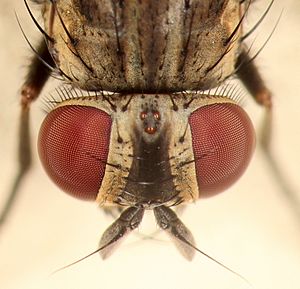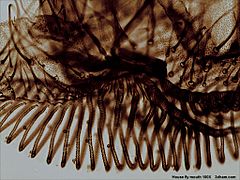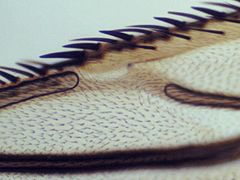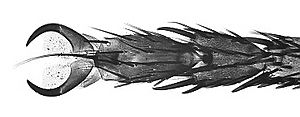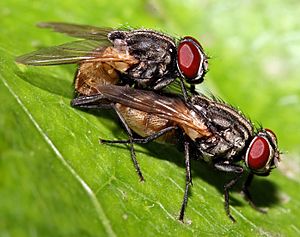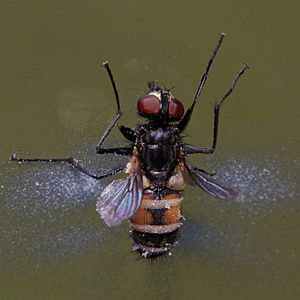Housefly facts for kids
Quick facts for kids Housefly |
|
|---|---|
 |
|
| Scientific classification | |
| Subspecies | |
|
The housefly (Musca domestica) is a common fly. It is thought to have first appeared a very long time ago, possibly in the Middle East. Since then, it has spread all over the world. Houseflies live closely with humans. They are the most common fly species found in our homes.
Adult houseflies are usually gray to black. They have four dark lines on their back. Their bodies are a bit hairy. They have one pair of clear wings. Houseflies have red eyes. The female's eyes are set a bit farther apart.
Female houseflies lay about 100 eggs at a time. They lay them on rotting things like food waste, dead animals, or feces. These eggs quickly hatch into tiny, white, legless larvae called maggots. After a few days, these maggots change into reddish-brown pupae. Pupae are about 8 millimetres (3⁄8 inch) long.
Adult flies usually live for two to four weeks. They can sleep through the winter in cold places. Adult flies eat many liquid or semi-liquid foods. They also eat solid things after softening them with their saliva. Houseflies can carry pathogens (germs) on their bodies and in their poop. This can make food unsafe and spread food-borne illnesses. Because of this, they are seen as pests.
Scientists have used houseflies in labs. They study how flies age and how their sex is decided. Houseflies also appear in old stories and poems. Sometimes, they show how short life can be.
Contents
What a Housefly Looks Like
Adult houseflies are usually 6 to 7 mm (1⁄4 to 9⁄32 in) long. Their wingspan is about 13 to 15 mm (1⁄2 to 19⁄32 in). Female flies often have bigger wings than males. Males have longer legs. Flies in colder places tend to be larger.
The fly's head is rounded in front and a bit cone-shaped in the back. Males' large compound eyes are very close together. Females' eyes are wider apart. They also have three simple eyes called ocelli. They have a pair of short antennae. Houseflies see things much faster than humans. This helps them escape when someone tries to catch them. They see our movements in slow motion.
Houseflies have special mouthparts for eating liquids. Their jaws are very small and don't work. Other mouthparts form a flexible tube called a proboscis. This tube has a spongy tip. This tip has many grooves that suck up liquids like a sponge. It also helps spread saliva to soften solid foods.
Houseflies can taste with their legs! They have taste organs on their feet. This lets them find sugars by walking on them. You often see flies rubbing their legs together. This cleans their taste organs. Each leg has a pair of claws. Below the claws are two sticky pads called pulvilli. These pads help the fly walk on smooth walls and ceilings. They use a special force called Van der Waals forces. The claws help them unstick their feet for the next step.
The fly's body (thorax) is gray, sometimes black. It has four dark lines on its back. The whole body is covered with short hairs. Like other Diptera (two-winged insects), houseflies have only one pair of wings. Their back pair of wings are tiny structures called halteres. These help them stay stable when they fly.
The wings are clear with a yellow tint near their base. A key feature is a sharp upward bend in one of the main veins. Each wing has a flap at the back called a calypter. This flap covers the haltere. The fly's belly (abdomen) is gray or yellowish. It has dark stripes and spots on the sides. It has 10 parts with small holes for breathing.
Many other fly species look similar to the housefly. Examples include the lesser house fly and the stable fly. Identifying them often needs special tools and close study.
Where Houseflies Live
The housefly is probably the insect found in the most places around the world. It lives closely with humans. It has traveled with people across the globe. You can find houseflies in the Arctic and in warm tropical areas. They are in all populated parts of Europe, Asia, Africa, Australia, and the Americas.
How Houseflies Evolved
Flies have been around for a very long time. True houseflies likely appeared at the start of the Cenozoic Era. This was a long time ago. Scientists think houseflies first came from the Middle East. Because they live so closely with humans, they probably spread worldwide by traveling with people.
The housefly was first officially named Musca domestica in 1758. This was done by a Swedish scientist named Carl Linnaeus. He described it based on common European flies. The name is still used today.
Housefly Life Cycle
Each female housefly can lay up to 500 eggs in her life. She lays them in groups of about 75 to 150 eggs. The eggs are white and about 1.2 mm (1⁄16 in) long. Flies lay them in good spots, usually on dead or rotting organic matter. This includes food waste, dead animals, or feces.
Within a day, tiny larvae (called maggots) hatch from the eggs. They live and eat where they were laid. They are pale white and 3 to 9 mm (1⁄8 to 11⁄32 in) long. They are thinner at the head end and have no legs. Larvae grow for two weeks in good conditions. In cooler conditions, it can take 30 days or more. Maggots don't like light. Piles of animal manure are great places for them to grow. They are warm, moist, and dark.
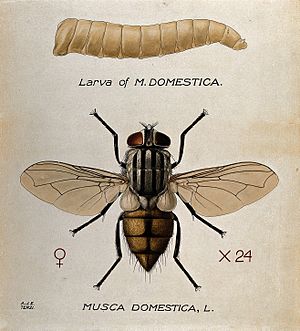
When the larvae are fully grown, they crawl to a dry, cool place. There, they change into pupae. The pupa case is shaped like a cylinder with rounded ends. It is about 1.2 mm (1⁄16 in) long. It forms from the last skin the larva shed. It starts yellow, then turns red, brown, and finally almost black as it gets older.
Pupae finish changing in two to six days if it's warm (35 °C (95 °F)). It can take 20 days or more if it's colder (14 °C (57 °F)). When the change is complete, the adult housefly comes out of the pupa. It uses a special pouch on its head to break open the pupa case.
Adult houseflies live from two weeks to one month in the wild. They can live longer in a lab. Once a fly comes out of the pupa, it stops growing. A small fly is not always a young fly. It just means it didn't get enough food when it was a larva.
Male houseflies can reproduce after 16 hours. Females can reproduce after 24 hours. Females make a special scent called a pheromone. This scent attracts males. This scent is sometimes used in fly traps to catch males.
Larvae need warmth and enough moisture to grow. The warmer it is, the faster they grow. Pig and chicken manure are often the best places for larvae to develop. This makes them grow faster and become bigger pupae. Other types of manure produce fewer, smaller pupae. If manure is too dry, no pupae will grow at all.
The whole life cycle can take seven to 10 days in perfect conditions. It can take up to two months in bad conditions. In places with seasons, 12 generations of flies can be born each year. In warm places, there can be more than 20 generations.
Housefly Ecology
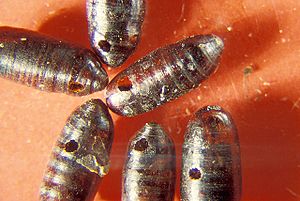
Houseflies are important in nature. They help break down and recycle dead organic matter. Adult flies mostly eat meat. Their main foods are dead animals and feces. But they also eat milk, sugary things, and rotting fruits and vegetables. They soften solid foods with saliva before sucking them up. They can also sometimes feed on blood.
Houseflies are active during the day and rest at night. If they are inside a building after dark, they gather on ceilings or wires. Outside, they hide in leaves or tall grass. In colder places, some houseflies hibernate in winter. They hide in cracks or folds of curtains. They wake up in spring when it gets warm. Then they look for a place to lay their eggs.
Many animals eat houseflies. These include birds, reptiles, frogs, other insects, and spiders. Housefly eggs, larvae, and pupae have many parasites. Some important ones are tiny wasps. These wasps lay their eggs inside housefly larvae. The wasp babies then eat the fly larvae. Some beetles also eat housefly larvae in manure piles. Tiny mites eat housefly eggs. Each mite can eat 20 eggs a day!
Houseflies sometimes carry other small creatures that don't harm them. These include mites and pseudoscorpions. A fungus called Entomophthora muscae causes a deadly disease in houseflies. The fungus grows inside the fly's body, killing it in about five days. Infected flies sometimes try to find warm places. This might slow down the fungus's growth.
Houseflies can also carry a tiny worm that attacks horses. A virus can also spread among houseflies. This virus makes their spit glands bigger. Infected female flies cannot have babies.
Houseflies and Humans
Houseflies can be annoying. They bother people at home and at work. But mostly, people dislike them because they make food dirty. They fly between dirty places where they lay eggs and our food. When they land on food, they soften it with saliva and leave their poop. This can spread germs and cause health problems.
However, housefly larvae are full of nutrients. They can be used to turn waste into animal feed. This feed can be given to farmed fish and other livestock. Housefly larvae have been used in traditional medicines in China for a long time. They are seen as a good source of useful substances.
Houseflies have appeared in art and objects in many cultures. In old European paintings, flies sometimes reminded people that life is short. Fly charms were popular in ancient Egypt.
Spreading Diseases
Houseflies can fly several kilometers from where they are born. They carry many tiny living things on their hairs, mouthparts, and in their vomit and poop. These can include tiny cysts and eggs of worms. Houseflies do not get sick themselves from these germs. But they can carry over 100 different pathogens (germs). These germs cause diseases like typhoid, cholera, and salmonellosis. This makes them especially dangerous in hospitals or during disease outbreaks.
Germs on the outside of a fly can live for a few hours. Germs inside a fly can live for several days. Usually, there are not enough germs on the outside of a fly to cause sickness. The main ways flies spread sickness are by throwing up or pooping on food.
In the early 1900s, people thought controlling houseflies was important for stopping diseases like tuberculosis. In Montreal in 1912, there was a "swat that fly" contest for children. Houseflies were also targeted during a polio outbreak in 1916. People believed that controlling flies was key to controlling diseases. They used a lot of bug spray until the mid-1950s. In China, between 1958 and 1962, people were told to catch and kill houseflies. This was part of a big campaign.
In Waste Management
Housefly larvae can eat and grow in many kinds of rotting organic matter. This is important for recycling nutrients in nature. This ability can be used to help deal with the growing amount of waste. Housefly larvae can be grown in large numbers in animal manure. This helps reduce the amount of waste. It also lowers the environmental risks of getting rid of it. The harvested maggots can then be used as food for animals.
How to Control Houseflies
We can control houseflies in several ways. These include physical, chemical, or biological methods. Physical controls include using screens with small holes. Or, you can use plastic strips or strings of beads in doorways. These stop flies from entering buildings. Fans that create air movement can also keep flies out.
Food places often use fly-killing devices. Sticky fly paper hanging from the ceiling works well. But electric "bug zappers" should not be used directly over food. They can scatter tiny, dirty insect parts.
Another way to control flies is to get rid of places where they can lay eggs. Keeping garbage in closed containers and collecting it often stops eggs from growing into adults. Dirty trash dumps are a main place for flies to breed. But if garbage is covered with soil every day, this can be avoided.
Insecticides (bug sprays) can also be used. Larvicides kill the growing larvae. But you might need a lot to reach deep areas. Sprays in the air can kill flies inside buildings. But outside, they only work for a short time. Sprays on walls or resting spots last longer. Many types of houseflies have become resistant to common insecticides. This means the sprays don't work on them anymore.
Scientists are also looking into using other living things to control flies. This is called biological pest control. One idea is to introduce another type of fly, the black soldier fly. Its larvae compete with housefly larvae for food. Another idea is to use dung beetles. They dig up manure piles, making them bad for housefly breeding. Releasing parasitic wasps can also help. But houseflies breed so fast that their natural enemies can't always keep up.
In Science
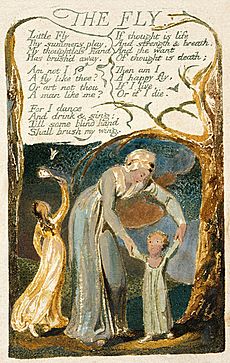
Houseflies are easy to raise in labs. They are also easier to handle than fruit flies. This makes them useful for scientific studies. Houseflies have a small number of chromosomes, either 6 or 12. Because some of their cells live a long time, they can be used to study how cells change as they age. One study found that damage to their DNA increased with age. This supports the idea that cell damage causes aging.
Houseflies are studied for how their sex is decided. Most animals have one way to decide sex. But houseflies seem to have many ways. This makes them very interesting to scientists.
The special substances made by housefly maggots are also being studied. They might be useful in medicine. Studies of flies flying while tied down have helped us understand how insects see, sense things, and control their flight.
In Literature
"The Impertinent Insect" is a group of old stories. They are sometimes said to be by Aesop. They are about an insect, sometimes a fly, that acts very important. In the Bible, flies are part of a plague and represent death. The name of a god, Beelzebub, might mean "lord of the flies." In Greek myths, a god named Myiagros chased away flies during sacrifices.
William Blake's 1794 poem "The Fly" talks about how flies die easily. It compares this to how humans also face death from things they can't control. Emily Dickinson's 1855 poem "I Heard a Fly Buzz When I Died" also talks about flies when someone dies. In William Golding's 1954 book Lord of the Flies, the fly is a symbol for the children in the story.
Ogden Nash's short 1942 poem "God in His wisdom made the fly/And then forgot to tell us why" is funny. It shows that even annoying creatures like flies have a place in nature.
See also
In Spanish: Mosca doméstica para niños


